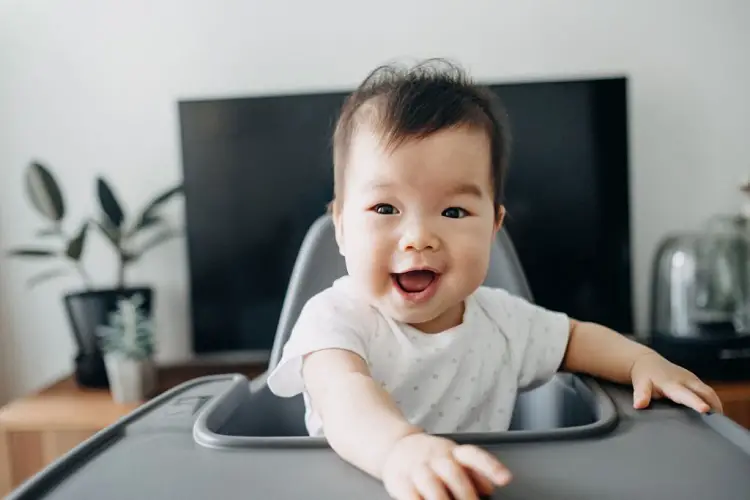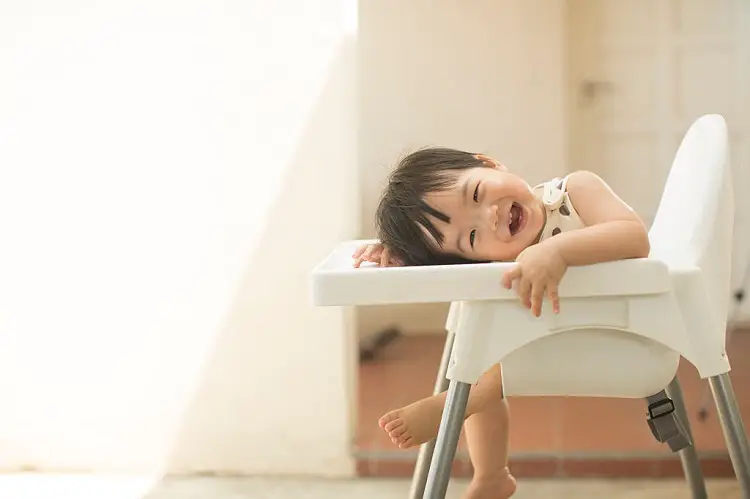Are you worried that your baby rocks back and forth in a high chair, and you are wondering how to stop baby rocking in high chair to prevent knocking the chair over?
Rocking in babies is very common and shouldn’t be something you worry about, as there are times when it is a means of achieving developmental milestones.
In rocking, babies move back and forth rhythmically, which is typical behavior, except if you start noticing signs that it is far from normal, then you can seek the help of a healthcare provider.
This article discusses everything you need to know about rocking and how to stop your baby rocking in high chairs.
Baby Rocking: Everything You Need To Know
Rocking of the body by a baby is most times a developmental milestone. It is essential for efficient mobility on the part of your child, and it helps babies meet those movements and developmental milestones.
It is also a sign that your baby is trying to explore his motor skills, and they may be trying to develop them.
Babies often notice the movement of body parts at 6-9 months, which may continue to occur for some time and may reach a few years.
Each rocking phase may last for a few seconds; should it progress into minutes, it is usually for a few minutes.
One of the reasons babies rock in their highchair is to draw their parents’ attention; if they fail to get their parents’ attention, they usually stop rocking.
Why Do Babies Rock In a High Chair?
Rocking a high chair with your child can convey many meanings and interpretations.
It could indicate that your baby is feeling particularly playful or even that your baby may be trying to acquire the leg and arm strength required to start crawling efficiently.
If your baby is on all fours, then you shouldn’t worry, as experts believe that rocking in high chairs should be encouraged for babies on all fours.
The reason for such an assertion is that it is necessary for efficient mobility on the part of your child, and it helps babies meet those movements and developmental milestones.
If your baby is around 7 months and has shown signs of crawling, then rocking shouldn’t be something you lose sleep over.
It is a sign that your baby is trying to explore his motor skills, and they may be trying to develop them.
Rocking on a high chair could result from your baby reacting to its external environment. You can tell if this is the reason for your baby’s rocking by the baby’s reaction and emotions.
Babies can also rock in a high chair when they want to soothe themselves, as it helps them to ease into a restful state.
However, if the behavior continues to rock on his high chair past 2, we recommend you consult with your doctor to ensure there are no developmental disorders.
When Should I Be Worried about My Baby’s Rocking?
Having established that rocking in a high chair may not be a thing to lose sleep about, there are times when it should be a source of worry. You will observe signs in your rocking child, and you will suspect that it is no longer business.
Some of the signs that should be a cause for worry for you include the following.
- It is no longer normal if you notice that your baby’s rocking is repetitive and trance-like. When you see this movement is not done happily, it may indicate a condition called autism. When you notice this, please seek professional help to ensure that it is not what you suspect, and your baby’s pediatrician can do this.
- If your baby’s rocking is accompanied by the frequent and intense banging of the head on the wall while in bed, then it could be a developmental problem and should be a source of concern. Do not hesitate to book an appointment with your baby’s pediatrician and have everything sorted out.
- It could signify that your baby is uncomfortable and upset about something. At this stage in their lives, they can’t talk, so most information is conveyed through gestures.
Read Also: When Do Toddlers Stop Using High Chairs
How To Stop Baby Rocking In High Chair

If you are wondering how to stop baby rocking in high chair? Well, the answer you seek is to try your best to ignore your baby’s attention-seeking behavior.
The movement is very common to babies, who feel they can get their parents’ attention when they rock, so if you try ignoring them, rocking will stop.
There are no special tactics used to stop a baby from rocking in a high chair, but there are a few tricks you can explore to help you cope, and they are
- Changing their high chairs to a booster seat (with a strap to keep your baby secured). You can do this by removing the back; this will help fix the rocking immediately.
- Another way to stop a baby rocking in a high chair is by securing the chair to the floor. Just place heavy objects (books or sandbags) on the lowest horizontal beam, which connects the front and back legs. This will make the high chair too heavy for your baby to rock.
- You can also strap and bolt the high chair to a wall or floor to stop your baby from rocking it back and forth.
In addition, while turning a blind eye, always keep an eye on any of the three signs mentioned earlier, which may suggest that the rocking indicates an abnormality with your child’s developmental well-being.
Also, while you turn a blind eye to your baby’s rocking spree, you must keep a close eye, especially if your child behaves in bed.
Ensure the crib is slightly away from the wall; this helps prevent your baby from banging his head on the wall.
You can also discuss with your baby’s pediatrician how frequently it occurs. If you feel it is a pointer to an abnormality, feel free to share with your baby’s pediatrician how you think the rocking spree is a pointer to an abnormality affecting your baby’s day-to-day activity negatively.
Read: 6 creative ideas to repurpose old high chairs
Is Rocking a Sign Of Autism?
Babies rocking back and forth may be an indicative sign of autism in certain situations. However, this is only true if it’s part of a larger pattern of signs and traits.
Here are some signs to look out for that may indicate autism
- The baby is rocking back and forth in a trance-like state while not making eye contact.
- Your baby rocks during the day instead of bedtime.
- Your baby rocks to dissociate himself from something overstimulating rather than self-soothing himself in a calm situation.
- Your baby rocks very hard so that it could cause him pain (for example, banging forcefully against the door).
Do not hesitate to consult your child care provider if you’re worried your baby might have a form of autism.
Also, while waiting for an appointment, we recommend you keep a diary of when the rocking or other weird behaviors are happening. If possible, take a video.
Related Posts:
- How To Clean High Chair Straps
- High Chair vs Booster Seat – Which is the Best?
- When Can a Baby Use a Restaurant High Chair? Explained
Conclusion
Has your question about “how to stop baby rocking in high chair” been answered? Hopefully, with time your baby will stop rocking in due time on their own.
As earlier mentioned, no special tactics are used to stop the baby from rocking in a high chair other than trying out any of the abovementioned tricks.
Always keep an eye to see if your baby’s rocking movement falls under any of the three signs suggesting that the rocking indicates an abnormality with your child’s developmental well-being.
Do not forget to discuss with your baby’s pediatrician how frequently it occurs.
If you feel it is a pointer to an abnormality, feel free to share with your baby’s pediatrician how you think the rocking spree is negatively affecting your baby’s day-to-day activity.
